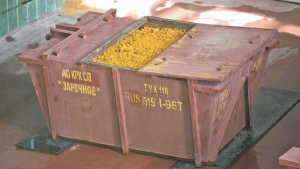Like the Anna character in the Rodgers and Hammerstein musical The King and I who sings “Getting to Know You” as she tries to build relationships with the wives and children of the King of Siam, Vadim Zhivov, director general of Russia’s Atomredmetzoloto (ARMZ) Uranium Holding, is trying to build a rapport with the shareholders of Canada’s Uranium One (UUU-T) with tell-all interviews about the history of the Russian company he heads and its powerful reach in the nuclear industry.
“We’re really well-known among countries within the Russian Federation,” Zhivov explained during a recent interview at the King Edward Hotel in Toronto. “But until now, we haven’t been keen on marketing outside Russia.”
But that changed since June, when ARMZ signed a deal with Uranium One to acquire a majority stake in the company, in exchange for its interest in two uranium mines in southern Kazakhstan and US$610 million in cash.
Under the proposed deal, Uranium One will issue 356 million shares to ARMZ, bringing the Moscow- headquartered company’s interest in Uranium One from 23.1% to at least 51%. Uranium One would issue a dividend of at least US$1.06 per share to its minority shareholders (except ARMZ).
Uranium One would get a 50% interest in ARMZ’s Akbastau mine and a 49.67% interest in the Zarechnoye mine, which would raise its total production by 30% in 2011 to 10.5 million lbs. of U308 and catapult it into the top five global uranium producers.
The addition of two low-cost uranium mines in Kazakhstan would also make it one of the world’s lowest- cost uranium producers. Costs would be in the range of US$10- US$20 per lb. uranium, about one-third cheaper than the majority of its peers, because ARMZ’s mines in Kazakhstan are mined in situ and tend to be less capital intensive, says Chris Sattler, Uranium One’s executive vice-president of corporate communications and investor relations.
While there are uranium mines in countries like Australia, Russia and the United States that are mined in situ, explains Sattler, Kazakhstan’s uranium deposits are “massive,” “very permeable” (sandstone) and “easier to mine.”
When it comes to the width of orebodies in Kazakhstan, Sattler continues, a typical uranium horizon is 7-8 metres thick, while in the U.S., by contrast, the typical thickness would run seven or eight feet.
ARMZ has a strong backbone, owned 80.34% by Russia’s Rosatom; it was established in 1992 but entered the global uranium market as an independent player in 2009.
Rosatom formed in 1945, and in the mid-1950s it established a nuclear power industry, diversifying into uranium mining, nuclear power plant construction (16% of global market share), power generation and sales.
Currently, Rosatom boasts 23.2 gigawatts of installed capacity, has built 32 reactors, and plans to build another seven within and outside the Russian Federation. It has 40% of the world’s uranium enrichment capacity and a 17% market share in nuclear fuel fabrication and supply, supplying nuclear power plants in Russia and 76 other nuclear power plants across 14 countries. (Annual export volume surpasses US$1 billion.)
“One-tenth of all the light bulbs in the U.S. are lit by fuel supplied by Russia,” Zhivov says. Indeed, since 1995, half of the nuclear fuel for U.S. nuclear power plants has been supplied by Russia, he maintains.
“During the Cold War everyone thought we were just producing nuclear warheads and missiles,” says Zhivov, a physicist by training, who prior to joining ARMZ five years ago worked at Gazprom (one of the world’s largest energy companies). “But we’ve become well-known among the Western nuclear industry as a major supplier of power and equipment.”
While some companies might worry about political risk in Kazakhstan, ARMZ isn’t one of them.
“We really have an advantage there,” Zhivov says, noting that 20 years ago Kazakhstan was part of Russia and the two countries share 100 years of history. The countries also share a 6,846-km land border and are parties to the same customs union.
By some estimates, about two-thirds of Kazakhstan’s population is ethnic Russian, who share the same language and have studied within the Russian Federation. The majority of geologists in Kazakhstan, for instance, received their degrees from universities in St. Petersburg or Moscow.
With those sorts of ties, ARMZ’s future in the former Soviet republic looks bright.
Says Sattler: “The perception of political risk should be reduced with this partnership.”
Uranium One shareholders are scheduled to vote on the proposed transaction on Aug. 31.


Be the first to comment on "Moscow’s ARMZ starts marketing itself"